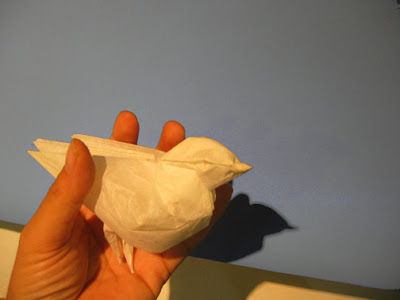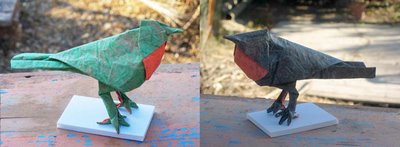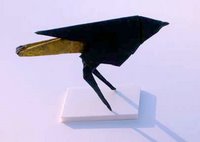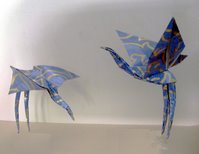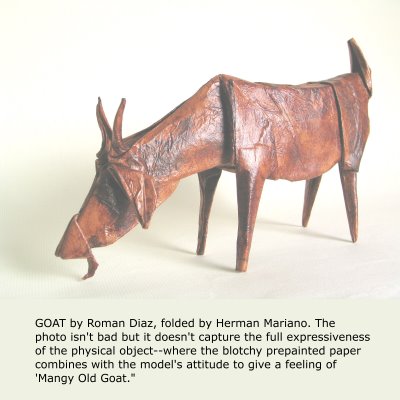There are different ways to engage and delight a viewer with something you’ve made, for instance, at the level of thought and at the level of feeling; but either way ‘engage’ usually means a mix of being clear and being obscure--both obscure and clear enough to make the viewer figure things out for himself and be able to reach the happy conclusion of recognition. With ‘model-making origami’ this happens almost automatically when the viewer recognizes simultaneously what the object is and that it is just paper with a few folds that the mind has figured out how to read. (So if the model is too detailed or if it is post-painted, we work less at translating it from paper-language and it gives less joy...) This would be a ‘cognitive’ ploy--it works at the level of thought, of recognition. But emotion comes into play in origami too, especially, it seems, with wet-folded models, for reasons I’m far from clear about.
A model can be stiff and cold and just say “this-is-a-that”, but it can also DO stuff and so engage the imagination in other ways. Think of the object as being like a noun: it can fit in lots of different sentences, or stories, but maybe there is not enough there to invite the imagination of them (unless you are a child). Well-made sculpture, as Roman points out in his comment, does not leave the thing to float entirely free, declaring just ‘X’, but often adds a bit of carefully-chosen adjective or verb to the noun (goat grazing, bird perching). When done right the posture or action seems as though it is about to change. That’s part of what gives the thing ‘life’: it has its own autonomy, a freedom of choice your imagination has granted it, to move beyond what is actually represented. When this succeeds, the object and you are bound up in a story-making relationship. (It is ‘interactive’, even if the wings don't move when you pull its tail.) And when the object is origami, and you're the one who has folded it, the imagination-space has been widened by a background of creation or parentage as well as by a link with the mind of the designer. A history of guided moves, along with the choices made and unmade. (Thanks Roman for helping me think this through.)
If the object is composed of several main parts, then you have a ‘sentence’ with more of the elements filled in: A is doing B to C (or stands in relation B to C). If the two parts are of equal weight, you tend to notice the verb more than the nouns—the sculpture is about the relationship. With more than two parts you are starting to control a whole story, with a protagonist to be identified with, subordinate clauses, a background scene etc. In my experience such sculptures tend to function more in painting mode than in sculpture mode; that is, they are sometimes less physically ‘present’, maybe because there is less freedom for the parts or the whole to do something other than what they are doing. Somebody is telling you a tale, the objects are not confronting you freely or directly and of their own accord. (
Mobiles are an exception that proves the rule.) --Sentences or stories exist in a different space than objects do. But even with stories the obligation remains of engaging the viewer’s imagination—by obscurity or by every other trick that will serve. And so you introduce, for instance,
suspense.
This is taking us a bit far afield. I wanted to focus here on the work of one great 'conceptual ' explorer, who has something to say about pure model-making (the naked noun, stripped of all verbiage) and also about the nature of paper itself.
He is of course Herman Van Goubergen. I will not be speaking here about all of his work, only the theme in it of the
two-sidedness of paper. (Another theme is the difference between flatness and three-dimensionality, but we have already been stressing that quite a bit in this blog.)
Three models of his come to mind.
First (1988?), there was his Lion-with-color-change. Now, color-changes are not uncommon in origami, today anyway, and if one is looking for pioneers here one certainly will think of Neal Elias before Herman Van Goubergen. But what strikes me with this model is that the color-change potential of paper is not just being
used, it is being
called attention to. The subject of this model is as much ‘The Color-Change’ as it is ‘The Lion’. I am not entirely sure how this is effected. Maybe it is because in the front of the model the color change comes out so cleanly at the right places and nowhere else; or maybe it’s because at the rear, exactly where the model is ‘anatomically correct’ it is also ‘color-change incorrect’. Attention is naturally drawn to that part of the anatomy anyway and when a further visual cue is added you become aware that both nature and art are engaging in some extra signaling—all of which stimulates
thought. (Thought, I insist, more than feeling: cold idea more than warm expression.)
The next model in this progression is ‘Above the Water, Under the Water’ (1996?): a model is posed on a glass ledge over a mirror; viewed from above you see a bird, but in the reflection from underneath you see a fish. —When I first encountered this model in Salzburg last year I immediately thought of M. C. Escher, who likewise was specially enamored of birds that turn into fish and with the idea that the same thing looked at from a different perspective can be a different thing. (Escher even has
some prints in which you look at a puddle of water, see things reflected in it, floating on it and submerged in it: above,
on and under). I pointed out these possible connections to Van Goubergen, an iconoclast and original thinker if ever there was one, and he seemed none too thrilled about them.
This model is using not just the color change but also the fact that an origami model almost always ends up with a top and a bottom (or a front and a back), and that it is by convention only that we attend to the top in mentally constructing a model out of what we see, while disregarding the messy underside. Once again Van Goubergen is calling attention to a fact about paper and paperfolds—or about ourselves. When other designers, most notably Joisel, find the two-sidedness of 3-D models objectionable they quite sensibly apply their immense ingenuity to hide or to eliminate it; Van Goubergen
makes use of this property and so forces us to consider it.
Nice and subversive.
But the apex of this progression has to be that VERY strange
Skull of his (diagrams in the Origami USA 1999 convention book and in Origami Tanteidan #72). A shape, not immediately recognizable, is placed on a mirror: now the reflected underside combines visually with the directly-seen top, and it becomes a skull. Brilliant! The color-change aspect has been done away with, the idea has been purified. It is now only about tops and bottoms. The model’s normally-ignorable underside can’t be ignored at all, because without it we don’t so much as have a visually constructible object. Bottom and top are of equal importance and neither is sufficient by itself for a unified model. Fantastic.
By the way: this sort of optical trick has not, so far as I know, ever been done before and it is something of an honor for us in origami that it was done in paperfolds first.
If you ask, technically, what the connection is between the idea of the color change and the top-and-bottom aspects of origami models, it is this. Paper starts out with two sides, which may be bi-colored; but while you can quickly hide the color (e.g., by a blintz) the result will still have two sides. The two-sidedness of the developing model continues essentially through all stages in which it is folded flat. Since three-dimensionality is usually given only at the very last stage, the model typically retains a top and a bottom, or an outside and an inside plus a seam-line, the latter of which we have no choice but to ignore.
This then is an ‘expression of an artistic idea’, in at least the following respects. It is an idea about
paper, or paperfolds; about the mental construction that parallels the physical construction of origami; about redeeming the ignored; about one thing that really always was two and two things that again become one.
Isn’t that a lot of 'idea' to pack into a single square of paper?
Saadya

















